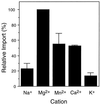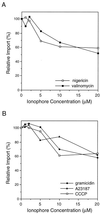Nucleotide triphosphates are required for the transport of glycolate oxidase into peroxisomes
- PMID: 9449847
- PMCID: PMC35171
- DOI: 10.1104/pp.116.1.309
Nucleotide triphosphates are required for the transport of glycolate oxidase into peroxisomes
Abstract
All peroxisomal proteins are nuclear encoded, synthesized on free cytosolic ribosomes, and posttranslationally targeted to the organelle. We have used an in vitro assay to reconstitute protein import into pumpkin (Cucurbita pepo) glyoxysomes, a class of peroxisome found in the cotyledons of oilseed plants, to study the mechanisms involved in protein transport across peroxisome membranes. Results indicate that ATP hydrolysis is required for protein import into peroxisomes; nonhydrolyzable analogs of ATP could not substitute for this requirement. Nucleotide competition studies suggest that there may be a nucleotide binding site on a component of the translocation machinery. Peroxisomal protein import also was supported by GTP hydrolysis. Nonhydrolyzable analogs of GTP did not substitute in this process. Experiments to determine the cation specificity of the nucleotide requirement show that the Mg2+ salt was preferred over other divalent and monovalent cations. The role of a putative protonmotive force across the peroxisomal membrane was also examined. Although low concentrations of ionophores had no effect on protein import, relatively high concentrations of all ionophores tested consistently reduced the level of protein import by approximately 50%. This result suggests that a protonmotive force is not absolutely required for peroxisomal protein import.
Figures







Similar articles
-
The surprising complexity of peroxisome biogenesis.Plant Mol Biol. 1998 Sep;38(1-2):163-89. Plant Mol Biol. 1998. PMID: 9738966 Review.
-
Translocation of acyl-CoA oxidase into peroxisomes requires ATP hydrolysis but not a membrane potential.J Cell Biol. 1987 Dec;105(6 Pt 2):2915-22. doi: 10.1083/jcb.105.6.2915. J Cell Biol. 1987. PMID: 3693402 Free PMC article.
-
Protein transport into higher plant peroxisomes. In vitro import assay provides evidence for receptor involvement.Plant Physiol. 1997 Apr;113(4):1213-21. doi: 10.1104/pp.113.4.1213. Plant Physiol. 1997. PMID: 9112774 Free PMC article.
-
Proton ionophores prevent assembly of a peroxisomal protein.Cell. 1987 Jan 16;48(1):165-73. doi: 10.1016/0092-8674(87)90367-9. Cell. 1987. PMID: 3539364
-
Signals, receptors, and cytosolic factors involved in peroxisomal protein import.Ann N Y Acad Sci. 1996 Dec 27;804:11-20. doi: 10.1111/j.1749-6632.1996.tb18604.x. Ann N Y Acad Sci. 1996. PMID: 8993532 Review.
Cited by
-
Import of the peroxisomal targeting signal type 2 protein 3-ketoacyl-coenzyme a thiolase into glyoxysomes.Plant Physiol. 2003 Dec;133(4):1991-9. doi: 10.1104/pp.103.028217. Epub 2003 Nov 20. Plant Physiol. 2003. PMID: 14630959 Free PMC article.
-
Peroxisome biogenesis and function.Arabidopsis Book. 2009;7:e0123. doi: 10.1199/tab.0123. Epub 2009 Sep 11. Arabidopsis Book. 2009. PMID: 22303249 Free PMC article.
-
The surprising complexity of peroxisome biogenesis.Plant Mol Biol. 1998 Sep;38(1-2):163-89. Plant Mol Biol. 1998. PMID: 9738966 Review.
-
A cell-free organelle-based in vitro system for studying the peroxisomal protein import machinery.Nat Protoc. 2016 Dec;11(12):2454-2469. doi: 10.1038/nprot.2016.147. Epub 2016 Nov 10. Nat Protoc. 2016. PMID: 27831570
References
-
- Balch WE. Small GTP-binding proteins in vesicular transport. Trends Biochem Sci. 1990;15:473–477. - PubMed
-
- Bellion E, Goodman JM. Proton ionophores prevent assembly of a peroxisomal protein. Cell. 1987;48:165–173. - PubMed
-
- Cline K, Ettinger WF, Theg SM. Protein-specific energy requirements for protein transport across or into thylakoid membranes. J Biol Chem. 1992;267:2688–2696. - PubMed
-
- del Valle R, Soto U, Necochea C, Leighton F. Detection of an ATPase activity in rat liver peroxisomes. Biochem Biophys Res Commun. 1988;156:1353–1359. - PubMed
Publication types
MeSH terms
Substances
Grants and funding
LinkOut - more resources
Full Text Sources

